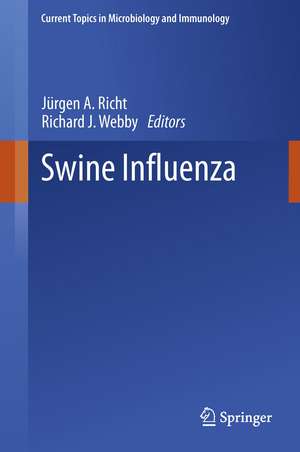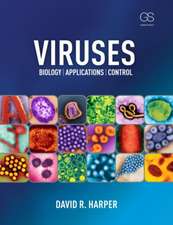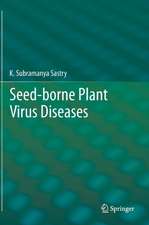Swine Influenza: Current Topics in Microbiology and Immunology, cartea 370
Editat de Jürgen A.. Richt, Richard J. Webbyen Limba Engleză Hardback – mai 2013
| Toate formatele și edițiile | Preț | Express |
|---|---|---|
| Paperback (1) | 945.47 lei 6-8 săpt. | |
| Springer Berlin, Heidelberg – 19 mai 2015 | 945.47 lei 6-8 săpt. | |
| Hardback (1) | 950.21 lei 6-8 săpt. | |
| Springer Berlin, Heidelberg – mai 2013 | 950.21 lei 6-8 săpt. |
Din seria Current Topics in Microbiology and Immunology
- 18%
 Preț: 962.03 lei
Preț: 962.03 lei - 5%
 Preț: 1123.13 lei
Preț: 1123.13 lei - 5%
 Preț: 1085.95 lei
Preț: 1085.95 lei -
 Preț: 499.77 lei
Preț: 499.77 lei - 5%
 Preț: 967.81 lei
Preț: 967.81 lei - 18%
 Preț: 1118.62 lei
Preț: 1118.62 lei - 5%
 Preț: 717.00 lei
Preț: 717.00 lei - 5%
 Preț: 712.97 lei
Preț: 712.97 lei - 5%
 Preț: 709.51 lei
Preț: 709.51 lei - 5%
 Preț: 709.51 lei
Preț: 709.51 lei - 5%
 Preț: 721.19 lei
Preț: 721.19 lei - 5%
 Preț: 359.78 lei
Preț: 359.78 lei - 5%
 Preț: 711.88 lei
Preț: 711.88 lei - 5%
 Preț: 774.81 lei
Preț: 774.81 lei - 15%
 Preț: 640.06 lei
Preț: 640.06 lei - 5%
 Preț: 717.00 lei
Preț: 717.00 lei - 5%
 Preț: 360.34 lei
Preț: 360.34 lei - 5%
 Preț: 707.69 lei
Preț: 707.69 lei - 5%
 Preț: 717.56 lei
Preț: 717.56 lei - 5%
 Preț: 716.28 lei
Preț: 716.28 lei - 5%
 Preț: 717.20 lei
Preț: 717.20 lei - 5%
 Preț: 711.32 lei
Preț: 711.32 lei - 5%
 Preț: 711.88 lei
Preț: 711.88 lei - 5%
 Preț: 718.29 lei
Preț: 718.29 lei - 5%
 Preț: 709.51 lei
Preț: 709.51 lei - 5%
 Preț: 369.84 lei
Preț: 369.84 lei - 5%
 Preț: 712.25 lei
Preț: 712.25 lei - 5%
 Preț: 716.45 lei
Preț: 716.45 lei - 5%
 Preț: 706.60 lei
Preț: 706.60 lei - 5%
 Preț: 711.52 lei
Preț: 711.52 lei - 5%
 Preț: 713.54 lei
Preț: 713.54 lei - 5%
 Preț: 720.47 lei
Preț: 720.47 lei - 5%
 Preț: 725.42 lei
Preț: 725.42 lei - 5%
 Preț: 708.06 lei
Preț: 708.06 lei - 5%
 Preț: 713.70 lei
Preț: 713.70 lei - 5%
 Preț: 705.83 lei
Preț: 705.83 lei - 5%
 Preț: 710.96 lei
Preț: 710.96 lei - 5%
 Preț: 723.93 lei
Preț: 723.93 lei - 5%
 Preț: 707.69 lei
Preț: 707.69 lei - 5%
 Preț: 715.35 lei
Preț: 715.35 lei - 5%
 Preț: 709.87 lei
Preț: 709.87 lei - 5%
 Preț: 359.05 lei
Preț: 359.05 lei - 5%
 Preț: 374.20 lei
Preț: 374.20 lei - 15%
 Preț: 635.31 lei
Preț: 635.31 lei - 5%
 Preț: 707.86 lei
Preț: 707.86 lei - 5%
 Preț: 721.96 lei
Preț: 721.96 lei - 15%
 Preț: 632.88 lei
Preț: 632.88 lei - 15%
 Preț: 632.05 lei
Preț: 632.05 lei - 15%
 Preț: 642.83 lei
Preț: 642.83 lei
Preț: 950.21 lei
Preț vechi: 1158.79 lei
-18% Nou
Puncte Express: 1425
Preț estimativ în valută:
181.83€ • 194.43$ • 151.60£
181.83€ • 194.43$ • 151.60£
Carte tipărită la comandă
Livrare economică 18 aprilie-02 mai
Preluare comenzi: 021 569.72.76
Specificații
ISBN-13: 9783642368707
ISBN-10: 3642368700
Pagini: 315
Ilustrații: X, 303 p.
Dimensiuni: 155 x 235 x 25 mm
Greutate: 0.58 kg
Ediția:2013
Editura: Springer Berlin, Heidelberg
Colecția Springer
Seria Current Topics in Microbiology and Immunology
Locul publicării:Berlin, Heidelberg, Germany
ISBN-10: 3642368700
Pagini: 315
Ilustrații: X, 303 p.
Dimensiuni: 155 x 235 x 25 mm
Greutate: 0.58 kg
Ediția:2013
Editura: Springer Berlin, Heidelberg
Colecția Springer
Seria Current Topics in Microbiology and Immunology
Locul publicării:Berlin, Heidelberg, Germany
Public țintă
ResearchCuprins
Preface.- Overview of influenza viruses.- History of swine influenza.- Genetics, evolution and the zoonotic capacity of European swine influenza virus.- History of swine influenza virus.- Clinicopathological features of swine influenza.- Diagnostics and surveillance for swine influenza.- Contemporary epidemiology of North American lineage triple reassortant influenza A viruses in pigs.- History and epidemiology of swine influenza in Europe.- Swine influenza viruses: an Asian perspective.- Swine influenza virus vaccines - to change, or not to change: that's the question.- Swine influenza virus infections in man.- Interspecies transmission of influenza A viruses between swine and poultry.- The 2009 pandemic influenza virus: Where did it come from, where is it now, and where is it going? - Pandemic influenza A H1N1 in swine and other animals.- Therapeutics against influenza.- Subject index.
Textul de pe ultima copertă
The central role which swine have played in the ecology of influenza is set out in this book in 15 chapters within a comprehensive international framework. The result is a ‘One Health’ perspective on the role of swine influenza viruses (SIVs) at the animal-human-environmental interface. The epidemiology of swine influenza worldwide is now of exceptional importance with the pig potentially acting as a “mixing vessel” where both avian and human influenza viruses can undergo genetic reassortment resulting in the creation of novel viruses that can cross species barriers.
The genetic features of SIVs with either limited or efficient spread to and between humans are largely unknown, but the host range barrier between human and swine highlights the fact that adaptation of a virus in one mammalian host does not necessarily mean that it is well adapted to replication in another. However, in 2012 zoonotic transmission of SIV (both H3N2 and H1N2 subtypes) containing the matrix gene from the 2009 pandemic H1N1 virus was reported. These strains appeared to be able to spread more easily from pigs to people than other influenza viruses of swine. Therefore, this multifaceted book has assumed greater significance. Clearly, the dynamic nature and the national and international complexity of SIVs pose challenges for the swine industry as a recurring respiratory disease in swine, and also for public health as a continuing source of zoonotic infection.
The genetic features of SIVs with either limited or efficient spread to and between humans are largely unknown, but the host range barrier between human and swine highlights the fact that adaptation of a virus in one mammalian host does not necessarily mean that it is well adapted to replication in another. However, in 2012 zoonotic transmission of SIV (both H3N2 and H1N2 subtypes) containing the matrix gene from the 2009 pandemic H1N1 virus was reported. These strains appeared to be able to spread more easily from pigs to people than other influenza viruses of swine. Therefore, this multifaceted book has assumed greater significance. Clearly, the dynamic nature and the national and international complexity of SIVs pose challenges for the swine industry as a recurring respiratory disease in swine, and also for public health as a continuing source of zoonotic infection.
Caracteristici
Provides contemporary reviews of research on Swine Influenza Virus Covers the critical area of vaccination and antiviral drugs against SIV Written by leading experts in SIV infection Includes supplementary material: sn.pub/extras




